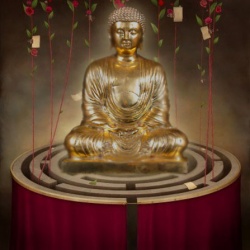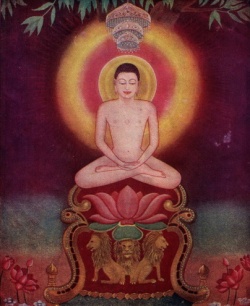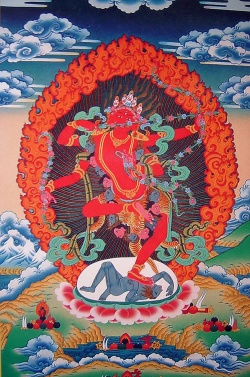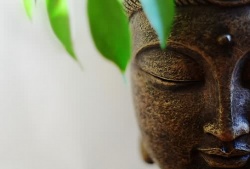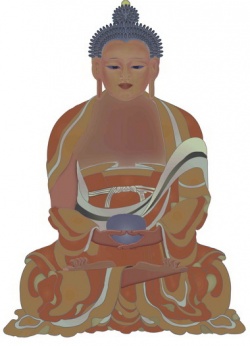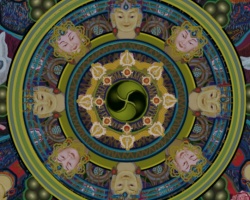(Anatta)
The Buddhist term Anatman (Sanskrit) or Anatta (Pali) is an adjective that specifies the absence of a supposedly permanent and unchanging self or soul in any one of the psycho-physical (namo-rupa) constituents of empirical existence; eg. “none of these khandhas are my Soul, are anatta (non-Self)”. What is normally thought of as the “Self” is in fact an agglomeration of constantly changing physical and mental constituents (”skandhas”) which give rise to
unhappiness if clung to as though this temporary assemblage formed some kind of immutable and enduring Soul (”atman”). The non-doctrinal commentarial “anatta” doctrine attempts to encourage the Buddhist practitioner to detach him/herself from this misplaced clinging to what is mistakenly regarded as his or her Self, and from such detachment (aided by moral living and
meditation) the way to Nirvana is able successfully to be traversed. All occurrences of anatta in Sutra contextually appear as: “A is anatta (not-Self), B is anatta, etc.”
A variant understanding of the doctrine (as enunciated by the Buddha in the Mahayana “Tathagatagarbha” scriptures) insists that the five “skandhas” (impermanent constituent elements of the mundane body and mind of each being) are indeed “not the Self” (”anatta”/”anatman”), since they are doomed to mutation and dissolution, but that in contrast to this
ephemeral “mundane self”, the eternal Buddha-Principle (”Buddha-dhatu”) deep within each being is the supramundane True Self - although this realisation is only fully gained on reaching Awakening (”bodhi”).
Anatta is one of the Three Seals of Buddhist doctrines and is an important element of wisdom through the apophatic technique used to experience Nirvana, the other two being Dukkha and Anicca.
Summary
Buddhist teaching tells us that all in life is impermanent and in a constant state of flux, and that any entity that exists does so only in dependence on the conditions of its arising, which are non-eternal. Therefore, any sense one might have of an abiding self or a soul is regarded as a misapprehension.
Buddhists hold that the notion of an abiding self is one of the main causes of human conflict, and that by realizing the nonexistence of our perceived self, ‘we’ may go beyond ‘our’ mundane desires. (Reference to ‘oneself’ or ‘I’ or ‘me’ for Buddhists is used merely conventionally.)
The Buddha in many later sutras, provided no confirmation the existence of a self or Atman a concept that was claimed central to many philosophers of his time, however in the oldest texts that exist in Buddhism, the Nikayas, the Buddha did at length affirm to his disciples (aryasavaka) that the “Soul was the only refuge, was the light within” [DN 2.100], and said the “Soul was that which was most beloved” (atta’ paramo piya). Rather than directing his listeners
to discover Atman, he taught that all clinging to concepts and ideas of a self are faulty and based on ignorance. The Buddha’s teaching was apophatic and was not aimed at any concept of self created by birth, imagination, speculation, metaphysical study or through self-ideation. The five aggregates of form, feelings,
perceptions, mental fabrications and consciousness were described as especially misleading, since they form the basis for an individual’s clinging or aversion. He taught that once a monk renounces his clinging for all the five aggregates, through meditative insight, he realizes the bliss of non-clinging, and abides in wisdom. The Buddha clearly stated
that all five aggregates are impermanent, just as the burning flame is inconstant in one sense, and that knowledge or wisdom is all that remains, just as the only thing constant about a flame is its fuel, or purpose.
Controversially, there has been and continues to be a minority of Mahayana Buddhists who understand the Buddhist doctrine of “non-Self” (”anatta”/”anatman”) as relating solely to the ephemeral elements (the five “skandhas”) of the being and not to the hidden and undying “Buddha-Principle” (”Buddha-nature”) taught by the Mahayana Buddha to exist within the deeps of each person’s mind (see section on “Anatman and the Tathagatagarbha Sutras” below).
Presecular position on anatta as presented in the Nikayas
The Buddhist term Anatman (Sanskrit), or Anatta (Pali) is an adjective in sutra used to refer to the nature of phenomena as being devoid of the Soul, the ontological and subjective Self (atman) which is the “light (dipam), and only refuge” [DN 2.100]. Of the 662 occurrences of the term Anatta in the Nikayas,
its usage is restricted to referring to 22 nouns (forms, feelings, perception, experiences, consciousness, the eye, eye-consciousness, desires, mentation, mental formations, ear, nose, tongue, body, lusts,
things unreal, etc.), all phenomenal, as being Selfless (anatta). Contrary to some popular books written outside the scope of Buddhist doctrine, there is no “Doctrine of anatta/anatman” mentioned anywhere in the sutras, rather anatta is used only to refer to impermanent things as other than the Soul, to be anatta.
Specifically in sutra, anatta is used to describe the nature of any and all composite, consubstantial, phenomenal, and temporal things, from the macrocosmic, to microcosmic, be it matter as pertains the physical body or the cosmos at large, including any and all mental machinations which are of the nature of arising and passing. Anatta in
sutra is synonymous and interchangeable with the terms dukkha (suffering) and anicca (impermanent), and all three terms are often used in triplet in making a blanket statement as regards any and all phenomena. “All these aggregates are anicca, dukkha, and anatta.”
Anatta refers only to the absence of the permanent soul as pertains any one of the psycho-physical (namo-rupa) attributes, or Khandhas (skandhas, aggregates). Anatta/Anatman in the earliest Buddhist texts, the Nikayas, is
an adjective, (A is anatta, B is anatta, C is anatta). The commonly held belief to wit that: “Anatta means no-soul, therefore Buddhism taught that there was no soul” is a concept, which cannot be found or doctrinally substantiated by means of the Nikayas, the sutras, of Buddhism.
The Pali term and noun for “no soul” is natthatta (literally “there is not/nonattha+atta’Soul), not the term anatta, and is mentioned at Samyutta Nikaya 4.400, where when Gotama was asked if there “was no soul (natthatta)”, equated this question to be equivalent to Nihilism (ucchedavada). Common throughout Buddhist sutra is the denial of psycho-physical attributes of the mere empirical self to be the Soul, or confused with same. The
Buddhist paradigm as regards phenomena is “Na me so atta” (this/these are not my soul), nearly so the most common utterance of Gotama Buddha in the Nikayas, where “na me so atta” = Anatta/Anatman. In sutra, to hold the view that there is “no-Soul” (natthatta) is = to ucchedavada (SN 4.400) [[[Wikipedia:Annihilationism|Annihilationism]]] = natthika (nihilist).
Logically so, according to the philosophical premise of Gotama, the initiate to Buddhism who is to be “shown the way to Immortality (amata)” [MN 2.265, SN 5.9], wherein liberation of the mind (cittavimutta) is effectuated through the expansion of wisdom and the meditative practices of sati and samadhi, must first be educated away from his former ignorance-
based (avijja) materialistic proclivities in that he “saw any of these forms, feelings, or this body, to be my Self, to be that which I am by nature”. Teaching the subject of anatta in sutra pertains solely to things phenomenal, which were: “subject to perpetual change; therefore unfit to declare of such things ‘these are mine, these are what I am, that these are my Soul’” [MN 1.232]
The one scriptural passage where Gotama is asked by a layperson what the meaning of anatta is as follows: Samyutta Nikaya 3.196] At one time in Savatthi, the venerable Radha seated himself and asked of the Blessed Lord Buddha: “Anatta, anatta I hear said venerable. What pray tell does Anatta mean?” “Just this Radha, form is not the
Soul (anatta), sensations are not the Soul (anatta), perceptions are not the Soul (anatta), assemblages are not the Soul (anatta), consciousness is not the Soul (anatta). Seeing thusly, this is the end of birth, the Brahman life has been fulfilled, what must be done has been done.”
The anatta taught in the Nikayas has merely relative value; it is not an absolute one. It does not say simply that the Soul (atta, Atman) has no reality at all, but that certain things (5 aggregates), with which the unlearned man identifies himself, are not the Soul (anatta) and that is why one should grow disgusted with them, become detached from them and be
liberated. Since this kind of anatta does not negate the Soul as such, but denies Selfhood to those things that constitute the non-self (anatta), showing them thereby to be empty of any ultimate value and to be repudiated, instead of nullifying the Atman (Soul) doctrine, it in fact compliments it.
What has Buddhism to say of the Self? “That’s not my Self” (na me so atta); this, and the term “non Self-ishness” (anatta) predicated of the world and all “things” (sabbe dhamma anatta; Identical with the Brahmanical “of those who are mortal, there is no Self/Soul”, (anatma hi martyah, [SB., II. 2. 2. 3]). [KN J-1441] “The Soul is the refuge that I have gone unto”. For anatta is not said of the Self/Soul but what it is not. There is never a ‘doctrine of no-Soul’, but a doctrine of what the Soul is not (form is anatta, feelings are anatta, etc.).
It is of course true that the Buddha denied the existence of the mere empirical “self” in the very meaning of “my-self” (this person so-and-so, namo-rupa, an-atta), one might say in accordance with the command ‘denegat seipsum, [Mark VII.34]; but this is not what modern writers mean to say, or are understood by their readers to say; what they mean to say is that the Buddha denied the immortal (amata), the unborn (ajata) and Supreme-Self (mahatta’) of the Upanishads. And that is palpably
false, for he frequently speaks of this Self, or Spirit (mahapurisha), and nowhere more clearly than in the too often repeated formula ‘na me so atta’, “This/these are not my Soul” (na me so atta’= anatta/anatman), excluding body (rupa) and the components of empirical consciousness (vinnana/ nama), a statement to which the words of Sankhara are peculiarly apposite, “Whenever we deny something unreal, is it in reference to something real”[Br. Sutra III.2.22]. It was not for the Buddha but for the nihilist (natthika) to deny the Soul.
Outside of going into the doctrines of later schisms of Buddhism, Sarvastivada, Theravada, Vajrayana, Madhyamika, and lastly Zen, the oldest existing texts (Nikayas) of Buddhism which predate all these later schools of Buddhism, anatta is never used pejoratively in any sense in the Nikayas by Gotama the Buddha, who himself has said: [MN
1.140] “Both formerly and now, I’ve never been a nihilist (vinayika), never been one who teaches the annihilation of a being, rather taught only the source of suffering, and its ending” Further investigation into Negative theology is the source which should be referenced in further understanding the methodology which the term anatta illuminates.
Due to secular propagation, a general acceptance of the concept of “A Doctrine of Anatta” exists as status quo, however there exists no substantiation in sutra for Buddhism’s denial of soul, or in using the term anatta in anything but a positive sense in denying Self-Nature, the Soul, to any one of a conglomeration of corporeal and
empirical phenomena which were by their very transitory nature, “impermanent (anicca), suffering (dukkha), and Selfless (anatta)”. The only noun in sutra which is referred to as “permanent (nicca)” is the Soul, such as Samyutta Nikaya 1.169.
In fact the phrase “Doctrine of anatta”, or “Anatmavada” is a concept utterly foreign to Buddhist Sutra, existing in only non-doctrinal Theravada and Madhyamika commentaries. As the saying goes, a “lie repeated often enough over time becomes the truth”. Those interested parties to Buddhism incapable of pouring through endless piles of Buddhist doctrine have defacto accepted the notion of a “Doctrine of anatta” as key to Buddhism itself, when in fact there exists not
one citation of this concept in either the Digha, Majjhima, Samyutta, Anguttara, or Khuddaka Nikayas. Unless evoking a fallacy, we must stick strictly to sutra as reference, wherein the usage of anatta never falls outside of the parameter of merely denying Self or Soul to the profane and transitory phenomena of temporal and samsaric life which is
“subject to arising and passing”, and which is most certain not (AN) our Soul (ATTA). Certainly the most simple philosophical logic would lead anyone to conclude that no part of this frail body is “my Self, is That which I am”, is “not my Soul”, of which Gotama the Buddha was wholeheartedly in agreement that no part of it was the Soul, i.e. was in fact anatta.
The perfect contextual usage of anatta is: “Whatever form, feelings, perceptions, experiences, or consciousness there is (the five aggregates), these he sees to be without permanence, as suffering, as ill, as a plague, a boil, a sting, a pain, an affliction, as foreign, as otherness, as empty (sunnato), as Selfless (anattato). So he
turns his mind away from these and gathers his mind/will within the realm of Immortality (amataya dhatuya). This is tranquility; this is that which is most excellent!” [MN 1.436]
The term anatman is found not only in Buddhist sutras, but also in the Upanishads and lavishly so in the writings of Samkara, the founder of Advaita Vedanta. Anatman is a common via negativa (neti neti, not this, not that) teaching method common to Vedanta, Neoplatonism, early Christian mystics, and others, wherein nothing affirmative can be said of what
is “beyond speculation, beyond words, and concepts” thereby eliminating all positive characteristics that might be thought to apply to the Soul, or be attributed to it; to wit that the Subjective ontological Self-Nature (svabhava) can never be known objectively, but only thru “the denial of all things which it (the Soul) is not”- Meister Eckhart. This doctrine is also called by the Greeks Apophasis.
Interpretive problems
Students of Buddhism often encounter an intellectual quandary with the teaching in that the concept of anatta and the doctrine of rebirth seem to be mutually exclusive. If there is no-self, no abiding essence of the person, it is unclear what it is that is reborn. The Buddha discussed this in a conversation with a Brahmin named Kutadanta.
There have been a number of attempts by various schools of Buddhism to make explicit how it is that rebirth occurs. The more orthodox schools claim that certain of the dispositions or psychological constituents have repercussions that extend beyond an
individual life to the next. More innovative solutions include the introduction of a Pudgala, a “person”, which functions comparably to the atman in the rebirth process and in karmic agency, but is regarded by its advocates as not falling prey to the metaphysical substantialism of the atman.
Others seek a proxy not for the atman but for Brahman, the Indian monistic ideal that functions as an atman for the whole of creation, and is in itself thus rejected by anatta. Such a solution is the Consciousness-only teaching
of the Yogacara school attempt to explain the seeming paradox: at death the body & mind disintegrates, but if the disintegrating mind contains any remaining traces of karma, it will cause the continuity of the consciousness to bounce back an arising mind to an awaiting being (i.e. a fetus developing the ability to harbor consciousness).
Some Buddhists take the position that the basic problem of explaining how “I” can die and be reborn is, philosophically speaking, no more problematic than how “I” can be the “same” person I was a few moments ago. There is no more or less ultimacy, for Buddhists, between the identity I have with my self of two minutes ago and the identity I have with the self of two lives ago.
A further difficulty with the anatta doctrine is that it contradicts the notion of a path of practise. Anatta followed to its logical extremities rejects the reality of a Buddhist practitioner able to detach him/herself from clinging.
Anatman (anatta) in the Tathagatagarbha Sutras
The understanding of “non-Self” (”anatta”/”anatman”) in the Mahayana scriptures known as the “Tathagatagarbha” sutras is distinctive and remarkable: the doctrine presented by the Buddha in these texts claims to clarify that it is only the
impermanent elements of the sentient being - the “five skandhas” (constituent elements of mind and body) - which are “not the Self” (”anatman”), whereas the truly real, immanent essence (”svabhava”) of the being is no less than the Buddha or the Buddha-Principle (”Buddha-dhatu” - “Buddha-Principle” or “Buddha-nature”), and is inviolate and
deathless. In the “Mahayana Mahaparinirvana Sutra”, this immortal Buddhic element within the being is termed the “True Self”. It is unaffected by rebirth and always remains intrinsically immaculate and uniquely radiant, only awaiting discovery from within the depths of the contaminated mundane mind of each being. In the “Tathagatagarbha Sutra” the Buddha tells of how,
with his Buddha-eye, he can actually see this hidden Buddhic “jewel” within each and every being: “hidden within the klesas mental contaminants] of greed, desire, anger, and stupidity there is seated augustly and unmovingly the tathagata’s Buddha’s wisdom, the tathagata’s vision, and the tathagata’s body. … all beings, though they find themselves with
all sorts of klesas, have a tathagatagarbha Buddhic essence, embryonic Buddha that is eternally unsullied, and that is replete with virtues no different from my own” (Lopez, 1995, p.96). Thus the “non-Self” doctrine receives a controversial presentation in the Tathagatagarbha sutras as merely partial truth rather than as absolute verity.
